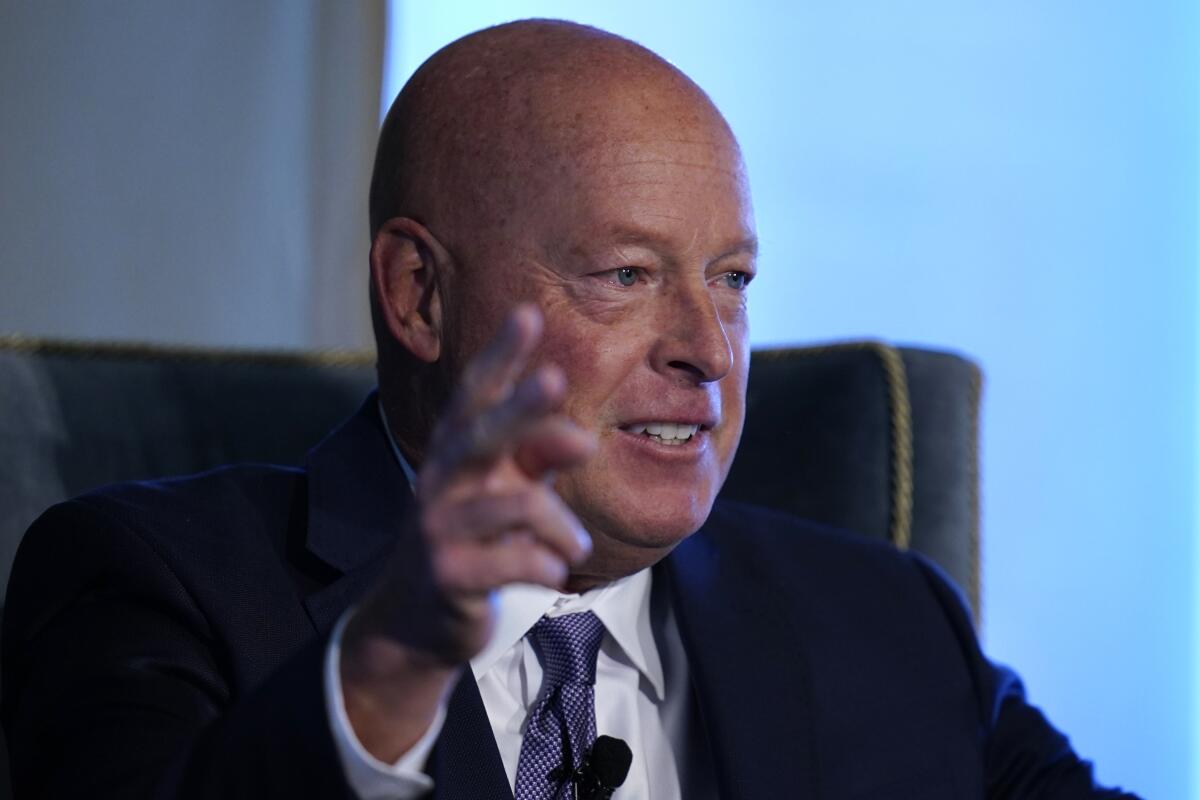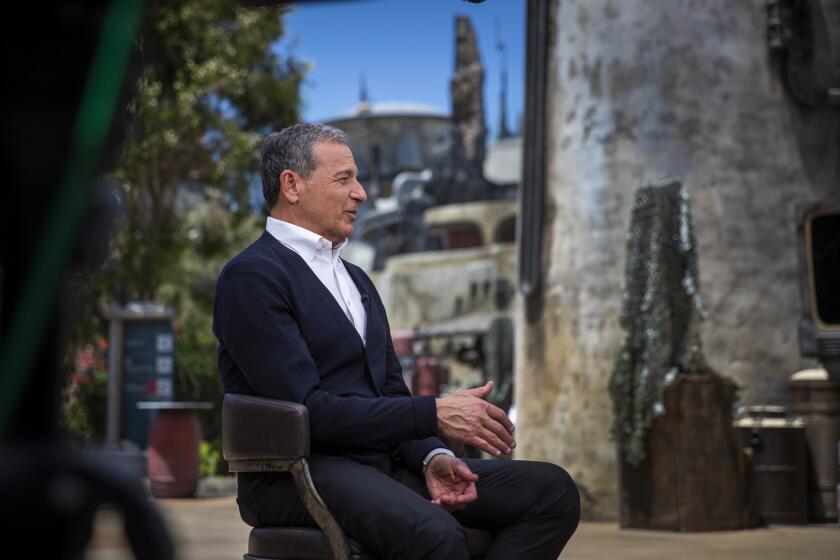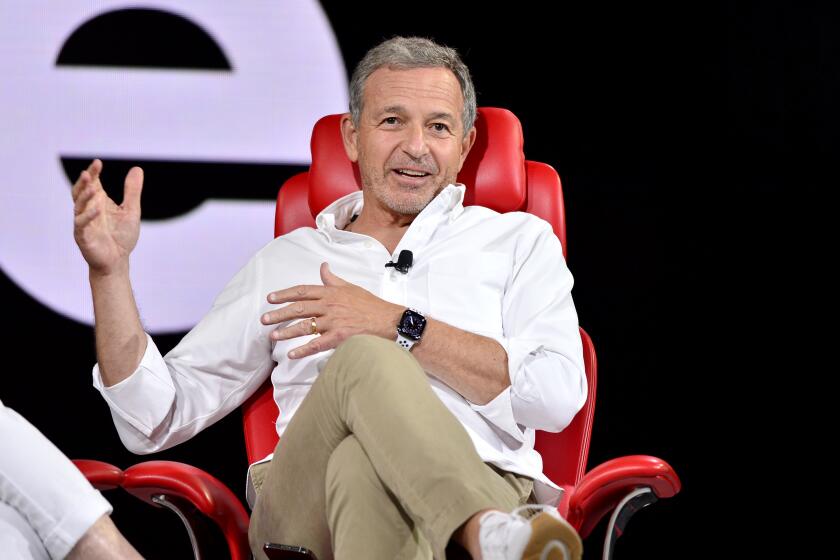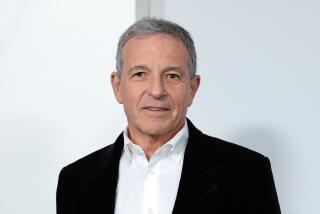Behind the stunning exit of Disney CEO Bob Chapek

- Share via
Five months ago, Bob Chapek seemed firmly in control.
Walt Disney Co.’s board of directors in June extended Chapek’s contract as chief executive of the legendary company for an additional three years, noting his leadership was key to “keeping Disney on the successful path it is on today.”
But on Sunday, Disney’s directors abruptly ditched Chapek, reinstalling his widely admired predecessor, Bob Iger, which elicited cheers from Wall Street and Disney’s faithful.
What happened?
Interviews with nearly a dozen Disney insiders, analysts and people close to the board suggest that Chapek’s problems had been mounting almost since the day he took Disney’s reins in late February 2020.
Within weeks, the economic environment had profoundly shifted as COVID-19 pandemic health precautions closed businesses, including theme parks, cruise lines and movie theaters, that had long buttressed the Burbank company. He also tried to expand Disney’s reach in streaming, a costly bet.
More debilitating, insiders said, was a series of miscalculations and missteps that undermined Chapek’s leadership and ultimately led to an unshakable loss of confidence.
Iger has already taken steps to undo some of the organizational changes made by his predecessor, but his return to the company comes with many challenges.
Tensions came to a head Friday when key Disney board members including Chair Susan Arnold approached Iger and invited him back as chief executive, the job he excelled at for 15 years, according to a person familiar with the matter who was not authorized to comment publicly.
Disney’s board moved swiftly because of concerns that Iger, 71, was considering a position to run another entertainment venture, according to two of the knowledgeable people. Not wanting to lose out, the board quickly struck a two-year agreement with Iger, who late Sunday sent an email to announce his return to Disney employees, shocking some who said they had to check the Iger email twice to make sure it was real.
The shuffle brought into full view the latest chapter of Disney’s long-running succession drama.
“Bob Iger’s shoes were impossible to fill,” said Jeffrey Cole, director of USC’s Center for the Digital Future. “Chapek wasn’t as diplomatic or elegant or smooth as Iger. ... He just wasn’t Central Casting’s idea of the CEO who would follow Bob Iger.”
Chapek was not available for an interview.
The short-tenured CEO is expected to leave Disney with at least $23 million, according to Bloomberg News. His contract, which had been scheduled to run to mid-2025, entitled him to collect a salary for the full duration of his agreed-upon term. Chapek also will collect his Disney pension — he’s worked at the company nearly 30 years — and if Disney’s stock recovers, he could reap even more.
Chapek, 62, rose through the ranks, working in the company’s home video division during the era of VHS tapes and rising to lead its consumer products unit and later its theme parks business. There, Chapek oversaw a number of major projects, including the opening of the company’s new theme park in Shanghai, and the debut of the “Star Wars”-themed lands in California and Florida. Several executives who worked for him described him as well-meaning, focused on streamlining the company to succeed in a more challenging environment.
Executives interviewed for this story pointed to several key moments that they said helped seal Chapek’s fate.
When Chapek was named CEO in February 2020, Disney’s board elevated Iger to executive chairman. Iger indicated he would relinquish the day-to-day operations to his former lieutenant and focus on working with creative types.
Then the pandemic hit.
Chapek was in the job less than two months when his authority was diminished. In April 2020, as the full ramifications of the COVID-19 pandemic were emerging, Iger told Ben Smith, then-New York Times media columnist, that he was still in the picture. Iger said he was “actively helping Bob [Chapek] and the company contend with [the pandemic], particularly since I ran the company for 15 years!”
The suggestion that Chapek needed “help” irritated Chapek and contributed to a frosty relationship between him and Iger that continued to this day, observers said.
Here are key players in the Walt Disney Co. leadership drama that saw the board bring Bob Iger back as CEO, replacing his former lieutenant Bob Chapek.
Some insiders criticized Chapek for nursing that resentment, saying he should have dutifully filled the role of apprentice because it was Iger who had tapped him for the top job and it was Iger who transformed the company, taking it from a $47-billion enterprise to a more than $250-billion behemoth. People close to Iger said the longtime chief simply wanted to be a resource for Chapek.
“But for Chapek, it seemed that Iger wouldn’t get out of the way,” one former executive said.
Chapek also failed to shake an image that he was simply an executive from the theme parks division, one who lacked a broad understanding or appetite for the fine points of running a creative enterprise that produces such hits as “The Mandalorian” or FX’s “American Horror Story.”
The handling of the Scarlett Johansson “Black Widow” dispute in July 2021 left many in Hollywood with a sour taste. Disney’s public statements suggested that one of the few female stars of the Marvel Universe was being greedy after Disney decided to release the movie on its streaming service, Disney+, rather than theaters, as envisioned when the contract was struck.
Hollywood agents, producers and some executives in the company chafed at Johansson’s treatment and the lawsuit that followed, an embarrassment for a company that had long prided itself for talent relations.
“Bob Chapek is a very good guy, but he was in over his head,” said Jeffrey A. Sonnenfeld, a senior associate dean at the Yale School of Management. “And he had a very slow taking-charge process that didn’t serve him well. The timetable is usually eight months for an insider. For an outsider, it often takes two years.”
“But Iger was still there, so this process was slow,” Sonnenfeld added.
Eager to restructure the company and streamline operations, Chapek designed a sweeping reorganization that centralized power in a longtime ally, Kareem Daniel. Daniel, a former consumer products chief, was put in charge of global strategy for the company’s streaming services. He was also the gatekeeper for financial decisions made by creative executives, which caused friction over priorities and budgets.
In his first move, Iger announced Monday that he would unwind Chapek’s centralized structure. Daniel, Iger said, left the company.
Iger was executive chairman for 22 months of Chapek’s reign. Even before Iger exited at the end of last December, several of his closest advisors announced they would retire, including communications chief Zenia Mucha and Disney general counsel and secretary Alan Braverman, who had joined Disney in 1993.
Walt Disney Co. ousted Bob Chapek and brought back Bob Iger to run the Burbank-based company, sending shockwaves through the industry.
Chapek brought in a former BP oil executive, Geoff Morrell, as his new communications and government relations chief. Morrell, a former Pentagon press secretary who also worked as a journalist at ABC News, also had a large portfolio. And he tried to manage the company’s response to Florida’s Parental Rights in Education law, which critics derisively nicknamed “Don’t Say Gay” legislation.
After weeks of staying silent on the legislation, Chapek reversed course and condemned the bill, handing Florida Gov. Ron DeSantis a win. The governor blasted Disney, saying Florida would not bend to a “woke” company. DeSantis moved to have Disney’s special self-governing status near Orlando revoked.
“He pulled something off that very few people could have done. He managed to offend both the DeSantis MAGA crowd and also the civil liberties crowd,” Sonnenfeld said. “It was handled so badly that he alienated both communities.”
Morrell lasted just three months.
Six weeks later, in a move viewed as an effort to consolidate his power, Chapek summoned Disney’s powerful head of television, Peter Rice, to his office and fired him, saying he wasn’t a good fit. Rice had joined Disney as part of the 2019 takeover of much of Rupert Murdoch’s Hollywood holdings, but Disney insiders said Chapek felt Rice had undermined him — he was frequently mentioned as a possible successor should Chapek get the boot.
Wall Street applauded Walt Disney Co.’s stunning move to replace CEO Bob Chapek five months after his contract was extended.
Disney’s board supported Chapek and gave him a new three-year deal — just days before Netflix reported a loss in customers, a seismic jolt to the industry. Suddenly, Wall Street was less enamored with the heavy losses media companies industrywide were incurring to build their own streaming services.
Activist shareholders began criticizing Chapek and his decisions, even suggesting that Disney sell ESPN.
The final straw came this month when Disney started its fiscal fourth quarter earnings call with analysts touting the wonders of the company, only to reveal that Disney had lost $1.5 billion on its streaming services, including Disney+, and the company might miss subscriber projections if a recession occurs.
Chapek’s next move was to announce cost-cutting and layoffs, alarming employees. “We literally learned from the press that there would be layoffs coming,” one insider said.
By this month, calls for change at the top had grown to a roar.
CNBC’s Jim Cramer went on a tear, saying Chapek needed to be fired.
“The board must have said, ‘We need somebody like Bob Iger,’” Cole said. “And then they said, ‘Well, what about Bob Iger?’”
Times staff writer Ryan Faughnder contributed to this report.
More to Read
Inside the business of entertainment
The Wide Shot brings you news, analysis and insights on everything from streaming wars to production — and what it all means for the future.
You may occasionally receive promotional content from the Los Angeles Times.














